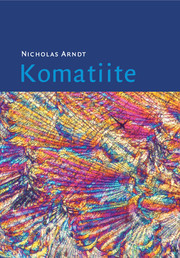Book contents
- Frontmatter
- Contents
- Preface
- Part I Background information – description of the field characteristics, mineralogy and geochemistry of komatiites
- Part II Interpretation – the manner of emplacement, the origin and the tectonic setting of komatiites
- 8 Physical properties of komatiites
- 9 Physical volcanology (by S. J. Barnes and C. M. Lesher)
- 10 Komatiite-associated Ni–Cu–PGE deposits (by C. M. Lesher and S. J. Barnes)
- 11 The hydrous komatiite hypothesis
- 12 Compositions and eruption temperatures of komatiitic liquids
- 13 Petrogenesis of komatiite
- 14 Geodynamic setting
- References
- General index
- Localities
- Plate section
10 - Komatiite-associated Ni–Cu–PGE deposits (by C. M. Lesher and S. J. Barnes)
from Part II - Interpretation – the manner of emplacement, the origin and the tectonic setting of komatiites
Published online by Cambridge University Press: 27 August 2009
- Frontmatter
- Contents
- Preface
- Part I Background information – description of the field characteristics, mineralogy and geochemistry of komatiites
- Part II Interpretation – the manner of emplacement, the origin and the tectonic setting of komatiites
- 8 Physical properties of komatiites
- 9 Physical volcanology (by S. J. Barnes and C. M. Lesher)
- 10 Komatiite-associated Ni–Cu–PGE deposits (by C. M. Lesher and S. J. Barnes)
- 11 The hydrous komatiite hypothesis
- 12 Compositions and eruption temperatures of komatiitic liquids
- 13 Petrogenesis of komatiite
- 14 Geodynamic setting
- References
- General index
- Localities
- Plate section
Summary
Introduction
There are two main types of ore deposits associated with komatiites: primary magmatic sulfide deposits, mined chiefly for their nickel content with minor by-product Cu and PGEs, and secondary laterite deposits enriched in nickel and cobalt, developed over thick olivine cumulate units, the latter known thus far only in the Yilgarn Craton of Western Australia (Elias, 2006). The chromitite deposits of the Sherugwe district in Zimbabwe are probably also associated with komatiites (Tsomondo, 1995; Cotterill, 1969), but this chapter is concerned only with the sulfide deposits, which currently account for about 10% of the world's annual nickel production and about 18% of global sulfide nickel reserves (Hronsky and Schodde, 2006).
The first Ni–Cu–PGE deposit found in what are now recognized to be komatiites was the Alexo deposit in northern Ontario (Naldrett, 1966), which was discovered in 1907 and which has been mined intermittently since. However, not until 1966, after much greater amounts of mineralization were discovered by the Western Mining Corporation in the Kambalda region of Western Australia (Woodall and Travis, 1969), was it appreciated that a new class of Ni–Cu–PGE deposit in ultramafic rocks had been discovered. The association with komatiite lava flows was recognized soon thereafter (Ross and Hopkins, 1975).
- Type
- Chapter
- Information
- Komatiite , pp. 295 - 327Publisher: Cambridge University PressPrint publication year: 2008

